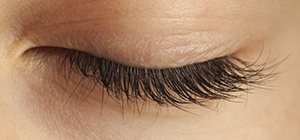
Q: What is Latisse?
Latisse is a prescription treatment for hypotrichosis that is meant to help promote the growth of longer, darker, and thicker eyelashes. Latisse is actually bimatoprost ophthalmic solution 0.03%. It sounds a little intimidating, but the bimatoprost ophthalmic solution is actually what is in Latisse that helps lashes grow longer and fuller. The 0.03% is the amount of the active ingredient involved. Bimatoprost is believed to help increase the anagen, or growth, phase of eye lashes as well as increasing the number of lashes within the anagen phase. However, the actual way this method works is unknown.
Q: Wait – what is hypotrichosis?
It is the term for not having enough eyelashes or inadequate eyelashes.
Q: How do I apply Latisse?
Easy. Every night, simply use the applicator to place the solution across your lash line. Do not use any method to apply Latisse other than the supplied applicator. It is best to use Latisse every night for at least 16 weeks to see the full results. It’s okay to miss a night or two, but avoid adding more the next night or in the morning. Simply continue as if you never missed a night and try to stay on schedule. Should you cease using Latisse, the results will be lost and eventually your lashes will return to the way they looked before you began using Latisse. This may take a few weeks or a few months.
Q: Does this mean I don’t have to use mascara anymore?
Not necessarily. It takes time for Latisse to work – up to 16 weeks to see the full results. While Latisse does improve your lash look for fuller, darker, and longer lashes, you may decide to keep using mascara in order to make them even fuller and longer. Depending upon your specific results, the decision to continue using mascara is yours.
Q: How is Latisse different from other nonprescription treatments?
Latisse is not only backed by proven clinical research, but it is also approved by the FDA, making it the first, and only, prescription treatment for lash growth and improvement.
Q: Does Latisse have any side effects?
Latisse has a very low occurrence of possible side effects, but there are a few to be aware of. Common side effects include itchy eyes or eye redness. Only 4% of the patients in the study reported these side effects. There are less common side effects that include:
- Skin hyperpigmentation – This is the darkening of the skin due to an increase of melanin (the brown pigment in skin that helps produce its normal color)
- Eye dryness or irritation
- Redness of the eyelids
- Intraocular pressure (IOP) changes – IOP may decrease as you use Latisse. If you are currently taking IOP-lowering medications, speak with your doctor before using Latisse.
Q: What happens if I get the solution in my eye?
Don’t worry. Latisse is an ophthalmic solution which means it is made specially for eyes and the areas around them, as they are particularly sensitive. There’s no need to rinse and it will not cause any damage to the eye.
Q: What do I do if I experience the side effects?
You may experience side effects immediately after using Latisse, however, these should only last for a short time until your eyes become used to the solution. The side effects alone are not proof of an allergic reaction and your eyes simply need time to adjust to this product. If you experience multiple side effects or any side effects persist longer than to weeks, speak with your doctor to find out if you should continue using Latisse.
Q: Is there anyone who shouldn’t use Latisse?
Anyone who is allergic to the ingredients in Latisse.
Q: Why can’t I use Latisse on my lower lashes too?
By applying Latisse only to your upper lash line, you are. Because Latisse is applied before you go to bed each night, when you close your eyes to sleep, your eyelids touch each other and some of the solution will be transferred over. Thus far the clinical trial was only used on the upper lash line. Overuse of Latisse can lead to the aforementioned side effects. It is always safest and most effective to follow directions.
